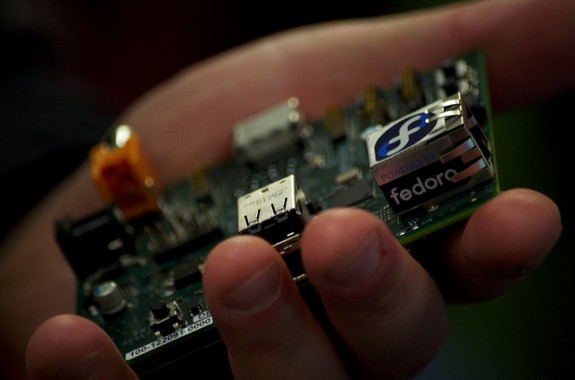The Amazing Things You Can Build With a $25 Computer
Computer-powered everything is coming from the creative endeavors of computer and electronics hobbyists—the ones who tinker just to see if it can be done

The Raspberry Pi is one of a wave of new low-powered, low-cost computers aimed at hobbyists. Photo: Jared Smith
The automated homes of the future and computer-powered everything, envisioned in shows like the Jetsons, may not come from large commercial conglomerates, but rather from the creative endeavors of computer and electronics hobbyists—the ones who tinker not necessarily for commercial gain, but just to see if it can be done.
In bid to drive this exploration, a few years back a group of University of Cambridge researchers released the Raspberry Pi, a $25 computer chip meant to be used for creation and exploration. With the low price, the hope is that people won’t be too miffed should their clever creations suffer some sort of catastrophe. A few months ago, a father-son pair strung together 64 of the little chips to create a supercomputer of sorts. In Ars Technica, Jon Brodkin highlights some of the other impressive, entertaining or downright odd contraptions that Raspberry Pi users have come up with using the cheap chips.
“Lots of people have installed gaming emulators on the Raspberry Pi,” says Brodkin, but some took the goal of gaming a few steps further. He points to a full working arcade cabinet running off the little chip, along with a functionally-reproduced Super Nintendo. The weirdest game-type creation of all, though, is one that you’d never expect from a standard manufacturer. (For one, the shelf life would be just awful.) One inventive coder came up with the BeetBox, a Raspberry Pi-powered contraption that lets you pound out drum beats by tapping beets.
Another inventor sent the chip to the edge of space, using the Pi to power a webcam that could beam images back to Earth.
And, in the UK, a user rigged the Siri voice recognition application on Apple’s iPhone to turn into a garage door opener. But, says Brodkin, the same basic idea can be used to automate all sorts of things around the house.
Many science fiction writers of the 20th century or earlier saw a world of 2012 that was (in some ways) far more fanciful than the world we face. But, if enough people are given room to play and create and explore, maybe we will catch up to those dreams.
More from Smithsonian.com:
50 Years of the Jetsons: Why The Show Still Matters
My Robot Helper of Tomorrow
This 6-Year Old Helped Build a Supercomputer out of LEGO And $25 Computer Chips
/https://tf-cmsv2-smithsonianmag-media.s3.amazonaws.com/accounts/headshot/smartnews-colin-schultz-240.jpg)
/https://tf-cmsv2-smithsonianmag-media.s3.amazonaws.com/accounts/headshot/smartnews-colin-schultz-240.jpg)